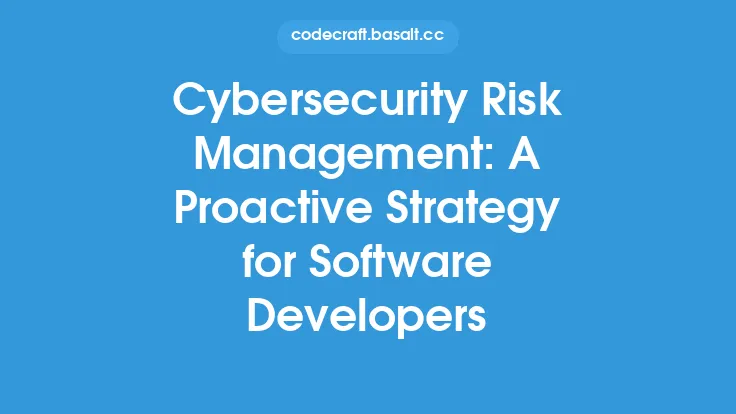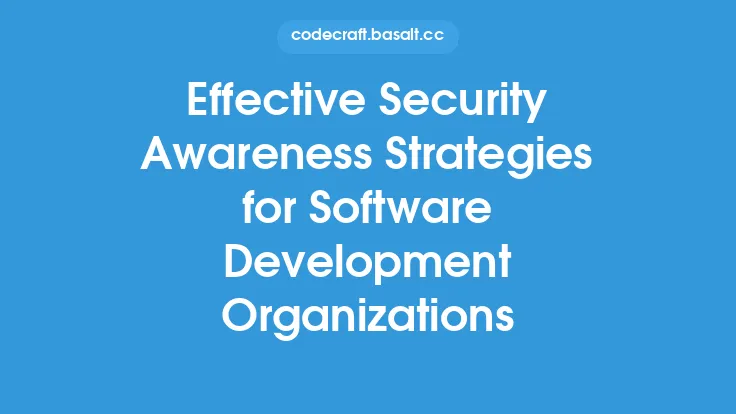Secure software development is a critical aspect of cybersecurity, and threat modeling is a crucial component of this process. Threat modeling is a systematic approach to identifying, analyzing, and mitigating potential security threats to an organization's assets. It involves a thorough examination of the organization's systems, networks, and applications to identify vulnerabilities and weaknesses that could be exploited by attackers. In this article, we will delve into the world of threat modeling for secure software development, exploring the concepts, principles, and best practices that underpin this essential cybersecurity discipline.
Introduction to Threat Modeling
Threat modeling is a proactive approach to cybersecurity that involves identifying potential threats to an organization's assets and developing strategies to mitigate or eliminate them. It is a critical component of secure software development, as it enables developers to design and implement secure software systems that are resilient to cyber threats. Threat modeling involves a thorough analysis of the organization's systems, networks, and applications to identify vulnerabilities and weaknesses that could be exploited by attackers. This analysis is typically performed using a variety of techniques, including threat modeling methodologies, risk assessments, and vulnerability testing.
Principles of Threat Modeling
Threat modeling is based on several key principles, including:
- Identify assets: The first step in threat modeling is to identify the assets that need to be protected. This includes data, systems, networks, and applications.
- Identify threats: Once the assets have been identified, the next step is to identify potential threats to those assets. This includes threats from insiders, outsiders, and natural disasters.
- Analyze vulnerabilities: The next step is to analyze the vulnerabilities and weaknesses that could be exploited by attackers. This includes vulnerabilities in software, hardware, and configurations.
- Develop mitigation strategies: The final step is to develop mitigation strategies to reduce or eliminate the risks associated with the identified threats and vulnerabilities.
Threat Modeling Methodologies
There are several threat modeling methodologies that can be used to identify and mitigate potential security threats. Some of the most common methodologies include:
- STRIDE: STRIDE is a threat modeling methodology that was developed by Microsoft. It involves identifying threats in six categories: spoofing, tampering, repudiation, information disclosure, denial of service, and elevation of privilege.
- PASTA: PASTA is a threat modeling methodology that involves identifying threats in seven categories: preservation, authentication, authorization, secrecy, tamper-proofing, availability, and anonymity.
- OCTAVE: OCTAVE is a threat modeling methodology that involves identifying threats in three categories: assets, threats, and vulnerabilities.
Benefits of Threat Modeling
Threat modeling offers several benefits to organizations, including:
- Improved security: Threat modeling helps to identify and mitigate potential security threats, reducing the risk of cyber attacks and data breaches.
- Reduced risk: Threat modeling helps to reduce the risk of cyber attacks and data breaches by identifying and mitigating potential vulnerabilities and weaknesses.
- Cost savings: Threat modeling can help to reduce costs by identifying and mitigating potential security threats before they occur.
- Regulatory compliance: Threat modeling can help organizations to comply with regulatory requirements and industry standards.
Best Practices for Threat Modeling
There are several best practices that organizations can follow to ensure effective threat modeling, including:
- Involve stakeholders: Threat modeling should involve stakeholders from across the organization, including developers, security professionals, and business leaders.
- Use a structured approach: Threat modeling should use a structured approach, such as a threat modeling methodology, to ensure that all potential threats are identified and mitigated.
- Continuously monitor and update: Threat modeling should be continuously monitored and updated to ensure that new threats and vulnerabilities are identified and mitigated.
- Use automation: Automation can be used to streamline the threat modeling process and reduce the risk of human error.
Common Challenges in Threat Modeling
There are several common challenges that organizations face when implementing threat modeling, including:
- Lack of resources: Threat modeling requires significant resources, including time, money, and personnel.
- Lack of expertise: Threat modeling requires specialized expertise, including knowledge of threat modeling methodologies and risk assessments.
- Complexity: Threat modeling can be complex, especially in large and complex organizations.
- Resistance to change: Threat modeling may require changes to existing processes and procedures, which can be resisted by stakeholders.
Future of Threat Modeling
The future of threat modeling is likely to be shaped by several trends, including:
- Artificial intelligence: Artificial intelligence is likely to play a major role in threat modeling, enabling organizations to automate the threat modeling process and reduce the risk of human error.
- Cloud computing: Cloud computing is likely to continue to grow in popularity, requiring organizations to develop new threat modeling strategies to protect their cloud-based assets.
- Internet of Things: The Internet of Things is likely to continue to grow in popularity, requiring organizations to develop new threat modeling strategies to protect their IoT-based assets.
- DevSecOps: DevSecOps is likely to continue to grow in popularity, requiring organizations to integrate threat modeling into their DevSecOps processes.
Conclusion
Threat modeling is a critical component of secure software development, enabling organizations to identify and mitigate potential security threats. By following best practices, using structured approaches, and continuously monitoring and updating their threat models, organizations can reduce the risk of cyber attacks and data breaches. As the threat landscape continues to evolve, threat modeling will play an increasingly important role in protecting organizations' assets and ensuring the security of their software systems.





